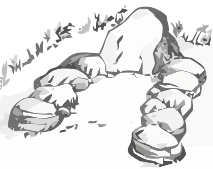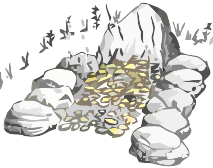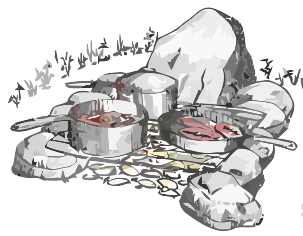Booklet/Cooking + Recipes
How to make food for a large group
During the Biketour you will sometimes be responsible for preparing food for the group. Not many people have experience in dealing with food for such a large group so no one is going to expect you to be an expert, but you will be expected to have a go and you never know you might have more skills than you realised! We all have different tastes so this is a chance to share yours with others, people wont always like it (too salty, too much garlic, not enough sauce etc) but we all take turns to make dinner.
When preparing food there are a few main things to think about:
- Quantity - There is no firm rule for quantities of food per person, so it's better to ask someone more experienced. Thinking about how many people we are and how much you would eat is also a good starting point. It's better to have too much than too little but we can't transport lots of extra food, and it's nice to not have soup all over the trailers.
- Timing - If you are part of a meal team it makes sense to arrive first. Know your speed and leave early with a group if you have to, and make sure you are with one of the trailer people. You could also combine carrying the trailer & cooking tasks.
What to get?
- Try to make healthy food that will give us the power to cycle
- Be aware of allergies and diets and ensure that all main meals are vegan
- Making a shopping list can help to deal with a limited budget.
- Don't buy tinned food when a dried version is available. Beans can be soaked in bottles along the way which saves on money and packaging
- Generally don't buy packaged food if an unpackaged version is available, paper packaging is better than plastic as it biodegrades. Avoid plasic bags.
- Avoid exotic and out of season fruit and vegetables
- Less processed food is generally cheaper
- Try to buy nutricious food rather than treats which people can buy themselves
Where to get food?
- Check the map to see where we will stay and try to predict where you can find stores, markets, farms and forests to get food on the way. Think carefully about opening and closing times (for example in some countries on Sundays or on national holidays).
- Look out for locals selling home made products along the way. It is GREAT to support them when we get the chance.
- Forage for food: look for wild fruit trees, berries, herbs for tea, plants for salad, wild mushrooms... Orchards often only harvest their trees once, so these are a good place to stop.
- Donations: If you think it is appropriate, you could ask for a food donation: wait till a moment when there are not so many customers in the store, introduce yourself, tell the biketour story and maybe sing a song or something else fun, and hope for the best!
- Search bakeries and try to secure some (free) bread in the late afternoon or near to closing time.
- Containers/bins/skips from shops: they are often filled with stuff that is perfectly delicious. Find them somewhere around the shops, they might be hidden away behind a fence or even locked.
Other things to think about
Often, there is packed lunch on the Biketour, so people pack food which has been prepared in the morning or the night before and eat it on the way. Particularly on hot days, food can easily spoil, so here are some tips to avoid that:
- Keep cooked and uncooked food separate. Cooked food is sterile and provides a delicious diet for the bacteria that live in the raw food. They will eat it really fast and it will ferment.
Nutrition
Soaking & Sprouting
Beans and grains are a time-honored way to get plenty of protein. Soaking and sprouting them greatly increases their quality and quantity, while reducing cooking times and therefore the fuel needed.
In nature, when it rains the nut or seed gets enough moisture so it can germinate and produce a plant. Sprouting is the practice of germinating seeds to be eaten either raw or cooked. It unlocks vitamins, minerals and enzymes while converting starches to simple sugars: making them much easier to digest and increasing their overall nutritional value up to 10 fold!
How to sprout: soak seeds in fresh water from 20 minutes up to 12 hours (see below). Drain them & leave them in a container where they can grow and expand. Rinse 2-3 times a day so mould doesn't grow on them. Sprouts are good to eat within a few days of sprouting because they begin to taste a bit bitter. Sprouting in and out of sunlight can make them different. Some sprouts cannot be eaten raw. Commonly sprouted seeds include (with their soaking time in brackets):
- Pulses: alfalfa(12hrs), fenugrec(6hrs), mung beans (8hr), pinto beans (12hrs), lentils(8hr),peas(8hr), chickpea (12hrs), soybeans (6hrs). Kidney beans (8hrs) must be cooked.
- Cereals: wheat (8hrs), maize/corn (12hrs), wild rice (12hrs), barley (hullless, 6hrs), rye (7hrs), kamut (7hrs), quinoa(3hr), millet(8hr),amaranth (4hr), buckwheat (6hrs).
- Vegetable and herb seeds: broccoli(8hrs), cabbage (5hrs), onion(5hr), radish(6hr), watercress (5hr) mustard(8hrs), clover(5hrs).
The seeds also normally need to be whole: ie. with their hull and not split. Some edible seeds may be heat-treated, thus making them impossible to sprout... so don't be dissappointed if some seeds just won't do anything. Go and experiment!
Even just soaking seeds is very useful. The main reasons for soaking nuts and seeds is to bring them out of quiescence and to remove their digestive inhibitors (seeds have these to protect themselves until it has what it needs for growing...like plenty of water!). They will expand (sometimes by 3 times) so make sure to have them in a container with plenty of extra space and water. eg. Soak 3 cups of almonds for 8 hours & rinse = yummy, healthier 3.5 cups of almonds! Don't soak pine nuts, pistachios or macadamias.
Warning: The most common foods to get food poisoning from: Meat, poultry, dairy, egg yolks, leftover cooked rice & raw sprouts. Commercially grown sprouts are associated with multiple outbreaks of harmful bacteria like salmonella or toxic forms of E coli- so be sure to use a clean container, clean water, don't leave them in the hot sun or sitting in water, allow some airflow and rinse your sprouts well!! :D
How to build a campfire for cooking
The object is to have all the wood turn into coals at the same time. This gives an even fire with no flames reaching up to burn your food or blacken your cookware. It also yields the longest cooking time from the coals.
Prepare the site

- Select a fire site at least 8' from bushes or any combustibles. Be sure no tree branches overhang the site. Take extreme care to avoid forest fires.
- Make a U-shaped perimeter using large rocks or green logs. If using logs, they'll need to be wet down from time to time. If breezy, have back of firepit face the wind.
- Put a large flat rock at the rear of the firepit to act as a chimney. The "chimney rock" will help direct the smoke up and away.
Lay the kindling

- Fill the fire area with crumpled paper or tinder.
- Lay kindling over paper in layers, alternating direction with each layer. Use thin splits of wood or small dead branches. Do not put kindling down “teepee style”. The whole fire area should be covered with the kindling stack.
- Set a bucket of water near the fire area. Light the paper to start your fire.
Build the fire, grade the coals

- When kindling is ablaze, add firewood. The wood should be all the same size, as much as possible. Use hardwood or hardwood branches if available. Distribute wood evenly over fire bed.
- As soon as the last flames die down leaving mostly white coals, use a stick to push the coals into a higher level at the back end and lower level at the front. This will give you the equivalent of 'Hi', 'Med' and 'Lo' cook settings. Or, level the coals to your preference. To cook, set the grill on rocks or wetted green logs. Put food directly on grill or in cookware and prepare your meal. If cooking directly on the grill, a small spray bottle or squirt gun is handy for shooting down any rogue flames, usually caused by food drippings. As the fire diminishes, bank the coals to get the most heat from them.

After cooking, add wood for your evening campfire. Before retiring, extinguish thoroughly and soak with water. Turn rocks in on fire bed. It will be easy to reassemble the next day if required.
Recipes
pippa's vegan curry type stuff
you need
- loads of onions
- loads of garlic
- loads of spinach or other green leafy vegetable, cut as small as you can be bothered to make it
- loads of potatoes, diced
- loads of rice or something to serve the curry with
- loads of tomatoes, cut up quite small
- salt
- chilli pepper
- ginger (plenty)
- coriander and cumin (maybe not so easy to get in eastern european villages, but in bigger places it shouldn't be so hard) (you need Indian cumin not european cumin)
- other curry type spices you can find such as garam masala, cardamom, mustard seeds
Instructions:
- boil the potatoes separately otherwise they will never cook.
- cook the rice if you are going to have some
- fry the onions and garlic then when they are done, add the spices and stir it around so that the spices are also a bit fried (but be careful not to obliterate them completely).
- add the tomatoes, spinach and cooked potatoes and cook together for a few minutes until the tomatoes have turned into a sauce and the spinach is cooked. et voila!
Pocket (w)One-ders
Here's a wonderful method for campfire cooking which is simple, versatile and doesn't even require cookware or a grill. All you need is some heavy-duty tin foil.
Tear off a 12 inch sheet of foil and fold it back over your fist, making a "pocket". Roll the sides in a few turns so the pocket is only open at the top, and roll a turn or two up from the bottom for extra strength. The pocket needs to be leak-proof, and formed well enough to withstand cooking directly in the coals. If your foil is thin, you may need two layers.
Start by lining the bottom of the pocket with thin slices of lemon. This helps keep the food contents from burning, and imparts flavour to the meal. Chop potatoes and carrots (cut small enough to cook all the way without overcooking everything else), tomatoes, mushrooms, peppers, onions, green beans, etc. and stuff the pockets. Add garlic, salt and pepper, olive oil, and a dash of cayenne. Add 1/4 cup of beer or water, fold the top edges of the pocket closed and set directly into the hot coals....it takes anywhere from 20 to 40 minutes, depending on how everything's cut. All the veggies slow roast in their own juices!
Roasted New Potatoes
- 2 lbs small new potatoes (washed)
- Olive Oil
- 2 tablespoons dried rosemary (you can also used thyme and oregano)
- 2 tablespoons garlic powder
- 2 tablespoons paprika
- 1 teaspoon black pepper, salt
In plenty of salted water, par-boil the potatoes until the tip of a knife can be inserted easily (roughly 10 minutes depending on size). Drain, then toss the potatoes in enough oil to just coat them, then toss with the rosemary, garlic powder, paprika and about 1 1/2 teaspoons salt as well as the pepper. On a campfire grill, grill over direct heat, turning often, until browned and grill marked, 10-15 minutes. Serves 6 - 8.
Delcious, slimy pumpkin soup
you need (4 Persons, please calculate):
- 1 onion
- 750 g pumpkin
- 750 g potatos
- 250 g carrots
- 2 cloves of garlic
- a piece of ginger
- 200 ml of vegetable stock
- ½ teaspoon Curry
- ½ teaspoon Kurkuma
- Salt and Pepper
- ½ teaspoon Garam Masala
Fry the onions, add quaters of potatos, carrots and pumpkin and the vegetable stock. Boil it for 10 min., then add ginger and the spices. Another 10 min. later you can take it off the fire (if the vegetables are soft), try to purree it with what you can find. Additional sauce: mix two soup spoons of Tahin with five soup spoons of soy milk and strew some sunflowerseeds on top.
Laura's Fruity Whole Oat Porridge (breakfast food)
Serves 4 – calculate! You can make quicker porridge by using rolled oats.
- 1 cup whole oat groats, soaked overnight in 5 cups water (organic if possible)
- 4 pieces of seasonal local fruit (eg pears, figs,apples), chopped, skin included
- Handful of nuts (eg almonds,walnuts), chopped, about 4 nuts per person is good
- ½ teaspoon cinnamon powder or two cinnamon sticks
- Pinch of sea salt and add sugar to taste
In the morning, bring the oats to the boil, adding enough extra water to stop them sticking to the pot. Add the cinnamon and cook for 20mins. Add the other ingredients, cook for another 5-10mins or until the oats are cooked through.
One-pot linguini with raw sauce
Serves 4 – calculate!
- 500g fresh tomatoes, cored and finely chopped
- 1 tablespoon chopped basil, 1 tablespoon chopped parsley
- 2 garlic cloves, minced
- 2 teaspoons salt
- 1 small red chile, seeded and minced
- 1/3 cup extra-virgin olive oil
- 350g linguine pasta (or another kind)
- 3 baby zucchini, thinly sliced
- Handful of sprouted seeds, lentils or beans (if you've been sprouting them)
- ½ cup freshly grated Parmigiano-Reggiano cheese for serving
In a large pot of boiling salted water, cook the linguine until al dente (still firm)
Drain the pasta well.
Add all the other ingredients to the pot and toss.
Lunch salads
- mix rice with spicy green lentil puree, add tomato and chick peas, shallot, lemon juice and cumin
- tomato, chickpeas, parsley
- spinach salad
- cucumber/carrot salad with lemon juice
- fennel salad with orange
- pasta salad
- quinoa salad
- bulgur salad
- beans salad
- potato salad
Spicy pumpkin-nut burgers
- grill and chop hazel nuts
- grate pumpkin
- add chopped onion
- bread crumbs or chickpea flour or oats or tomato paste for binding (instead of eggs)
- curry paste
- marjoram, rosemary, pepper, salt
Lentil burgers
- cook lentils in stock
- grate carrots
- bread crumbs or chickpea flour or oats or tomato paste
- olive oil
- pepper, salt
- finely chopped onion
Ratatouille (serves 30)
- 20 courgettes
- 10 aubergine
- 30 onions
- 25 tomates
- 2 kg couscous
- garlic
- spices
- stock

